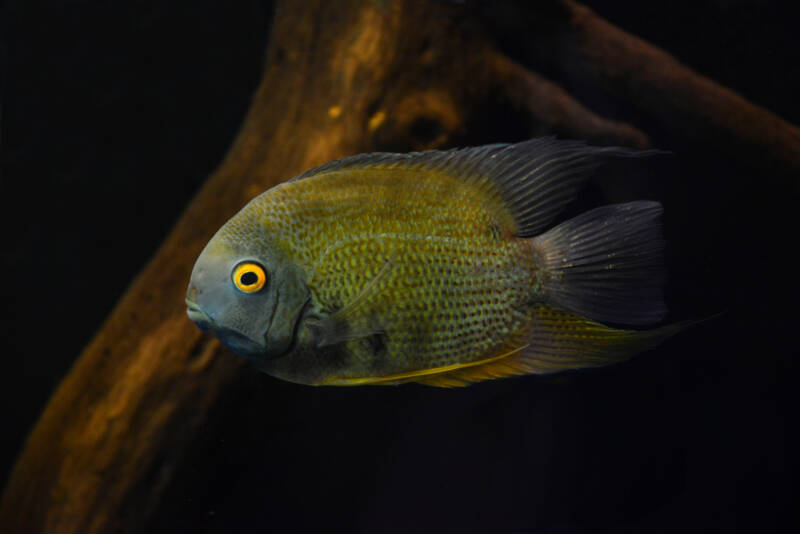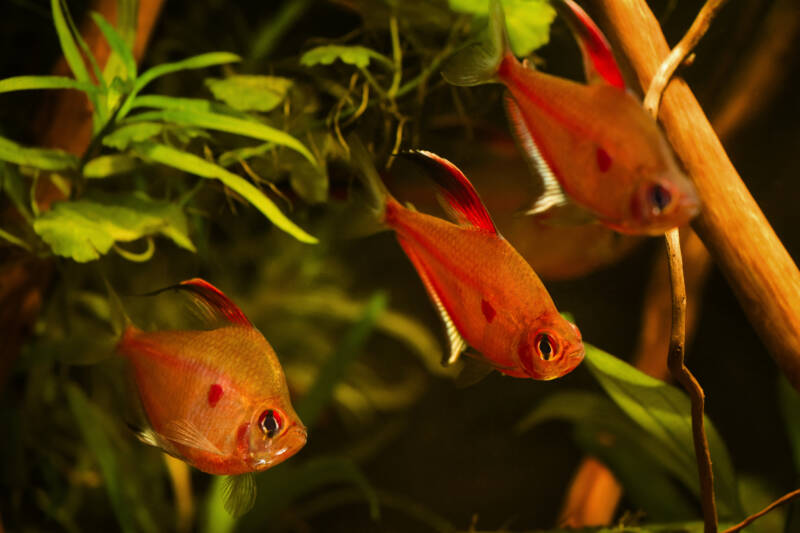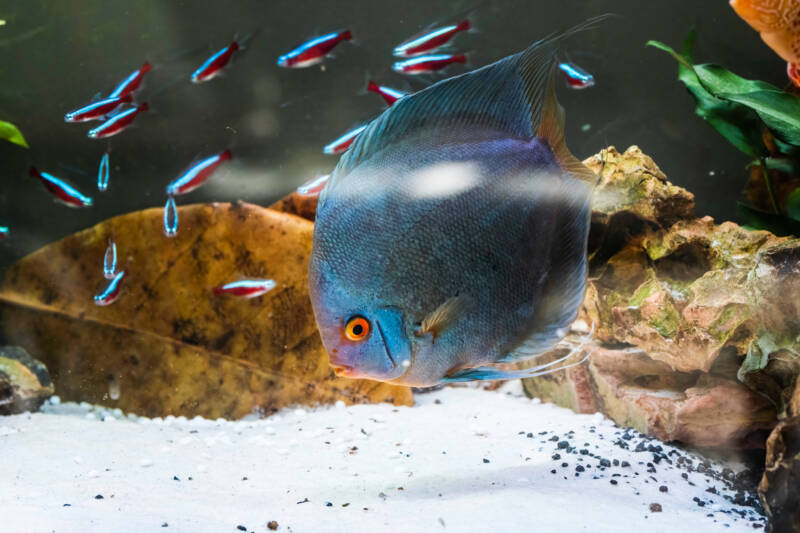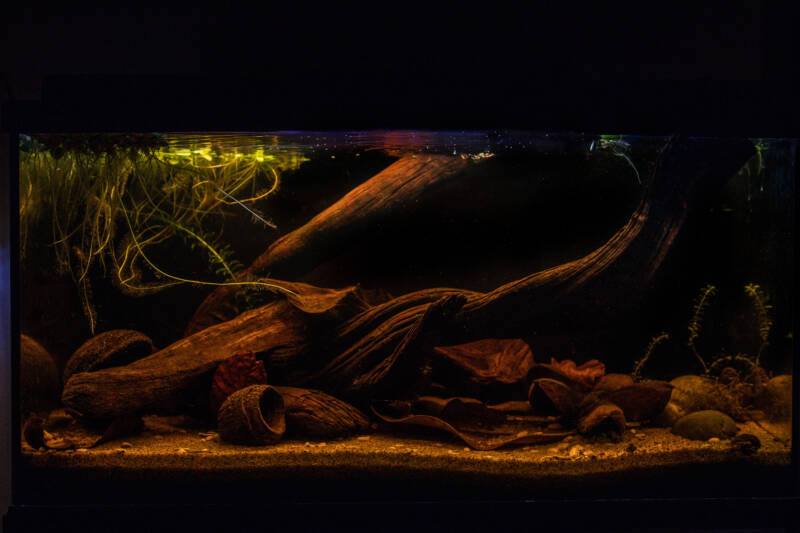If you’re looking for a new type of aquarium challenge, I suggest a blackwater aquarium!
Blackwater? You may be thinking this doesn’t sound like an attractive aquarium. Maybe it sounds a little mysterious.
Want to know more? I’ll explain what a blackwater aquarium is, why you want it and how to set one up.

[toc]
What is blackwater?
The Amazon River and its tributaries are classified as whitewater and blackwater.
Whitewater habitats have a neutral pH around 7.0, the water carries suspended particles and plenty of nutrients. The whitewater habitat is relatively clear.
Blackwater habitats have dark-colored, transparent water caused by large amounts of dissolved humic substances dissolving into the water. That’s because the rivers rise and extend into floodplains. If the floodplain happens to be a forest with lots of leaf litter, the water will become acidic and stained by the decomposing leaves, seeds, fruit, and wood.
This niche habitat is called igapó or “root forest” in Brazil. The twisted tree roots and humic acids create a unique freshwater habitat that’s home to over 200 species of fish.
Why is the water so dark?

When you mix water with logs, twigs, and leaves things start to decay. A combination of biological (bacteria and fungi) and chemical processes begin breaking down the organic matter. Humic substances contained in the plant material are released into the water.
In nature, humic substances are not just one chemical compound. The water contains a literal “soup” of all kinds of organic compounds. Humic acids are dark brown to black in color. Fulvic acids appear more yellowish.
The chemistry is complex but all you need to know is that these natural compounds tint the water and help to lower the pH.
What is a blackwater aquarium?
The idea behind blackwater aquariums is to simulate the water chemistry of Amazonian blackwater and have physical characteristics of the floodplains. This means the aquarium water needs to be low in minerals and aquascaped with live aquatic plants, aquarium wood, and organic matter (leaves) that will decompose.
Over time the aquarium will age, meaning the decomposing plant material will release natural acids and other compounds, causing the water to become tea-colored.
A blackwater aquarium is similar to a planted aquarium. The main task is maintaining a habitat for the plants along with a controlled decomposition of leaf litter.
Acid-loving freshwater fish are added to provide color, movement, and interest to the biotope. The fish also add nutrients and contribute carbon dioxide for the plants, creating a balanced ecosystem.
Fish that love blackwater aquariums

While a lot of the set-ups is focused on live plants and water chemistry, the fish that thrive in a blackwater tank are many!
There are over 200 species of freshwater fish that inhabit natural blackwater environments. You’ll have plenty to choose from for your tank. Some of these species can grow quite large. Be sure to do some research before selecting the fish.

Here are just a few of the more common fish that will thrive in a blackwater aquarium:
- Tetras (cardinals, neons, and others)
- Geophagus
- Brycon species
- Firemouth cichlids
- Discus
- Pimelodus catfish
- Loricariid catfish
- Uaru
- Gouramis
- Apistogramma.
Most aquarists choose to go with smaller schooling fish like tetras and some interesting catfish. Discus and angelfish thrive in a planted blackwater tank. Dwarf cichlids also do well in this type of aquarium.

How to set up a blackwater aquarium
Aquascaping is a personal thing. No two tanks are alike in their layout. I’ve compiled my “must-haves” based on years of setting up and maintaining blackwater aquariums.
Aquarium
Size does not matter. You can use a nano tank or build a 500-gallon river aquarium!
Substrate

A fine gravel (not sand) works well to anchor plants and provide a root zone. Many Amazonian fish like to sift sand while looking for live foods. You can go with a light-colored natural gravel or a darker specialty substrate for planted aquariums.
Lighting
Being under a forest canopy the blackwater biotope is somewhat dimly lit. If you don’t plan on using live plants almost any kind of aquarium light will work. I like to use a white daylight-style LED fixture. It makes it easier to see into the tea-stained tank.
White LED also creates light ripples throughout the tank, just like sunlight passing through the forest trees. If the fixture has the ability to adjust the color spectrum you can experiment to see which color blend brings out the colors of your fish. Many aquatic plants will grow well under medium-brightness LED lighting too.
Heater
A simple submersible heater will stabilize the water temperature in the 75-80°F (24-26.7°C) range.
Water
This is an important component of a blackwater aquarium. The water should be low in hardness (GH) and alkalinity (KH). The ideal range is in the 2-5-degree range.
If your tap water is harder, blend the hard water with reverse osmosis water to achieve the desired levels. It does not have to be exact. You just want the hardness to be less than 8 degrees. This will bring the water chemistry closer to the Amazonian conditions and allow the pH to slowly drop over time.
Water movement
With a smaller aquarium, a hang on the back-power filter may provide all the water movement you need. For larger tanks, a canister filter or power heads can be used to create a flow of water throughout the aquarium.
If you are raising live plants, don’t agitate the water surface too much. It will drive off the carbon dioxide plants need. If there are no plants you can aerate the water as much as you desire.
Filtration
I suggest using mechanical filter media to capture debris. Sponges, filter cartridges, and other types of mechanical media should be cleaned or replaced monthly. Activated carbon will remove some of the humic substances.
I suggest using activated carbon for only a week or so each month. This will remove some of the humic substances along with other undesirable organics that build up in the water. If your tank becomes too dark for your liking, use more activated carbon and change it weekly to reduce staining of the water.
Driftwood

Use any type of aquarium wood that is safe for the tank and is not known to raise pH. It provides a natural look and gives fish a place to explore.
Some aquarium woods will release tannins into the water. Manzanita wood is pH-neutral and looks great in your aquarium.
Rocks
Smooth stones and rough rock can be used to create a river bed or jagged outcropping. You must choose rocks that won’t release calcium (water hardness) or alkalinity (carbonates).
Some rocks will increase the pH by slowly releasing carbonate hardness (KH) into the water, so research before you purchase rocks.
Leaf Litter

Care must be taken when adding leaves to your tank. You don’t want to add just any leaf you find on the ground.
Indian almond leaves are readily available online and are completely safe. Alder cones are also used to increase tannins. Aquarists report these dried native tree leaves are safe and effective in the aquarium:
- Pedunculate – Quercus robur
- Sessile oak – Q. petraea
- Turkey oak – Q. cerris
- Red oak – Q. rubra
- European beech – Fagus sylvatica
- Hawthorn – Crataegus monogyna
- Japanese maple – Acer palmatum.
You may find prepared liquid “blackwater” additives. I am not sure if these formulations have the same benefits of the natural humic substances generated in the aquarium.
Just because a product makes your tank brown does not mean it has all the properties of humic and fulvic acids.
By all means, experiment and have fun. But I recommend trying natural plant matter in addition to prepared liquids.
How many leaves do I need?
There is no scientific answer on “dosing” with leaves or cones. Since they are not toxic you don’t have to worry about hurting the tank.
Almond leaves have been used at a rate of two leaves for 10-15 gallons. The dried leaves may take a day or two to soak up enough water to sink. Replace them every 30 to 60 days. You’ll have to experiment and judge for yourself.
Live plants
You don’t need to have live plants if you’re building a biotope that mimics a fast-moving stream, where plants wouldn’t normally grow. If you do choose live plants, select medium to low-light types.
I like to use a liquid fertilizer containing iron and other trace elements. I use a half dose at first until the plants start growing and need to be pruned. If the growth rate is satisfactory, I continue with a half dose. Under bright lighting, I use the full dose.
Experiment to find the right dose regimen for your aquarium.
pH and blackwater aquariums

The topic of acidic pH and freshwater fish is filled with facts and fiction.
In nature, the pH of natural waters can fluctuate wildly during the course of 24 hours. In the morning the pH can start out at 5, rise to 9 at noon and fall back to 5 in the evening. This normal rise and fall in pH are not stressful or harmful to the fish.
In an aquarium with low alkalinity, it will be natural for the pH to decline due to natural acids released through the biological filter. The humic acids will help to lower pH but they are not “strong” acids. They won’t lower the pH if your alkalinity is high. It is possible to run the tank below pH 6.
If you are not experienced with aquarium water chemistry or don’t want to closely monitor KH and pH levels, keep the pH around 6.5 to 7.0 by balancing the carbonate hardness in tap water with pH in your tank.
If you really like to test the water and make subtle changes in water chemistry, you can run the tank with 1 degree of alkalinity and achieve a pH around 5. Many tropical fish color up in an acidic environment, provided they are fed a balanced diet.
I’ve seen disease problems all but disappear under acidic conditions. As we’ll see, there is some science behind this observation.
I recommend these test kits for keeping an eye on your water chemistry:
- Low-range pH test kit
- Water hardness (GH & KH) test kit
- Ammonia & Nitrite (for periodic monitoring of biological filtration).
Fish health bonus
There is growing evidence that captive fish exposed to humic substances remain in better health and heal quickly all on their own.
Traditional medications cannot be used with fish intended for human consumption. This can cause a challenge for aquaculture fish farming.
Aquaculture researchers are finding that natural humic substances promote disease resistance and healing of damaged fins and skin. This appears to confirm what betta-keepers have been saying about almond leaves for many years. Captive fish stay healthier in a blackwater environment.
Maintaining the blackwater aquarium
Just like all aquariums, an Amazonian tank will benefit from water changes. My blackwater tanks don’t have a lot of fish and I feed carefully. There is not a lot of sludge in the gravel or build-up of algae-promoting nutrients like phosphate. I change about 20% of the water every three weeks.
If the tank is getting too “dark” I’ll increase the amount of water change or make them a little more frequently. If the gravel needs cleaning a light “sweep” with a gravel siphon is all that’s needed.
Final thoughts
A blackwater aquarium is fun and provides a challenge to both new and experienced aquarists. The key to success is to take your time. Allow the natural processes to break down the leaves and release all the beneficial substances into the water.
My tropical fish really color up, revealing subtle color patterns and iridescent scales that you just don’t see in a normal freshwater tank. I encourage you to set up a blackwater tank and see for yourself!
